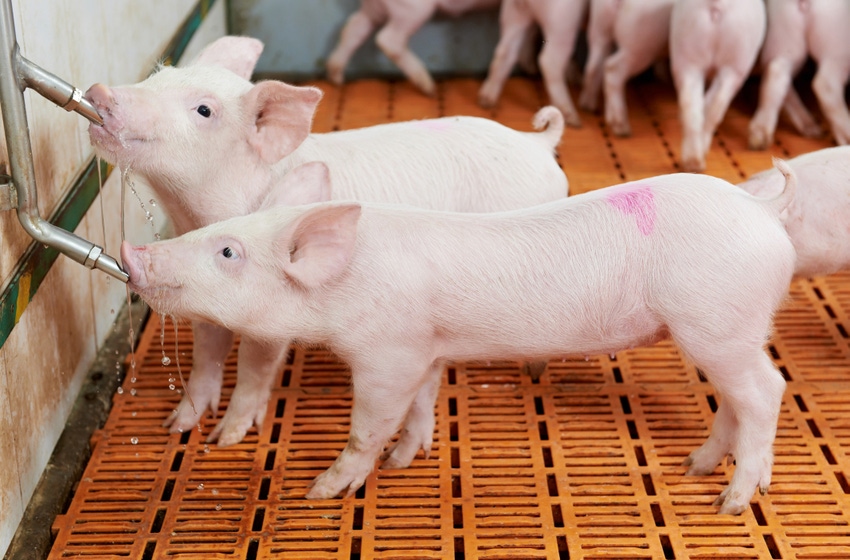Is weaning age or weaning weight more important?
Evaluating factors associated with nursery throughput.
April 8, 2021

Summary
Weaning weight and weaning age explained 83% of the variation in nursery exit weight
Birth weight explained 4% of the variation in nursery survival
Weaning weight explained 36% of the variation in the percentage of full-value nursery pigs
Older weaning ages and heavier weaning weights generally have favorable impacts on post-weaning throughput. However, which is more important in relation to nursery growth rate and maximizing the number of full-value pigs? The objective of the current study was to evaluate factors associated with nursery throughput.
Data consisted of 3,260 weaned pigs from 320 litters across five farrowing batches at the NCDA Tidewater Research Station (Plymouth, NC). At birth, piglets were weighed, ear notched, and administered iron. Prior to weaning, litters were provided sow lactation feed in a creep feeder. At weaning, piglets were weighed, tagged, vaccinated (for PCV2 and Ileitis), and transported to on-site nursery facilities. In the nursery, pigs were housed nine pigs per pen (2.5 ft.2 per pig). Nursery exit weights were collected after a 35-day feeding period.
Summary statistics across the farrowing batches are shown in Table 1. Weaning age was greater than today’s industry average. This was because the facility has ample farrowing space and leverages older weaning ages to reduce nursery feed cost. However, the standard deviation for weaning age (4.7 days) indicates a wide range of weaning ages (18 to 36 days) are included in the data set.

Using statistical models, we related farrowing batch, gender, average piglet birth weight, coefficient of variation in piglet birth weight, average piglet weaning weight, coefficient of variation in piglet weaning weight and weaning age to nursery average daily gain, nursery exit weight, nursery survival and full-value nursery pigs. Litter was the experimental unit.
Nursery growth rate
Pearson correlations between nursery average daily gain with gender, average piglet birth weight, coefficient of variation in piglet birth weight, average piglet weaning weight, coefficient of variation in piglet weaning weight, and weaning age were 0, 0.24, 0.09, 0.81, 0.10, and 0.73, respectively. As a statistics review, correlation (r) ranges from 1 to -1. A correlation of 0 indicates no relationship between two factors and a correlation of 1 or -1 indicates two factors are similar.
Significant factors related to nursery average daily gain included farrowing batch, average piglet birth weight, average piglet weaning weight and weaning age (model R2 = 0.80). Within these factors, average piglet weaning weight and weaning age explained 70% of the variation in nursery average daily gain. These results suggest nursery growth rate is highly dependent on pre-weaning growth rate and weaning age. Hence, increasing pre-weaning growth rate and/or weaning age would have the greatest impact on enhancing nursery growth performance.
Regression estimates showed a one-pound increase in average piglet birth weight and average piglet weaning weight increased nursery average daily gain by 0.0604 and 0.0194 pounds per day, respectively. A one-day older weaning age increased nursery average daily gain by 0.0206 pounds per day.
Nursery exit weight
Significant factors related to nursery exit weight included farrowing batch, average piglet birth weight, average piglet weaning weight and weaning age (model R2 = 0.88). Within these factors, average piglet weaning weight and weaning age explained 83% of the variation in nursery exit weight. Regression estimates showed a one-pound increase in average piglet birth weight and average piglet weaning weight increased nursery exit weight by 2.09 and 1.68 pounds, respectively. In other words, assuming 11 pigs weaned per litter, increasing total litter weaning weight by 11 pounds would increase litter nursery exit weight by 18.48 pounds. A one-day older weaning age increased nursery exit weight by 0.71 pounds.
Nursery survival
Of the factors studied only average piglet birth weight was significantly associated with nursery survival (Figure 1), explaining only 4% of the variation. In agreement, Fix (2010) and Declerck (2016) reported greater piglet birth weights were associated with greater nursery survival.

In the current study, weaning age was not associated with nursery survival. In contrast, Main (2004) and Fix (2010) reported nursery survival increased linearly as weaning age increased. Weaning ages in those studies were 12 to 22 days and 18.7 ± 2.1 days, respectively, younger than the average weaning age in the current study (28.1 days). Taken together, perhaps these studies suggest that there is a curvilinear association between weaning age and nursery survival.
Sow parity was not included in the current study as farrowing batch was completely confounded with parity. Fix (2010) reported piglets from greater parity sows had better nursery survival.
Nursery survival in the current data set was 98.7%. Perhaps the relatively high nursery survival rate made it challenging to identify factors related to nursery survival. Interestingly, average piglet birth weight had a greater relationship with nursery survival than traits measured later in life, such as average piglet weaning weight and weaning age.
Full-value pigs
In the current study, the percentage of full-value nursery pigs did not include nursery mortality and pigs with a nursery exit weight of less than 30 pounds. Thirty pounds at nursery exit was chosen as an example threshold level. We did not intend to define a full-value nursery pig for the industry as weight or pig quality thresholds may vary by production system.
Significant factors related to the percentage of full-value nursery pigs (model R2 = 0.44) included farrowing batch, average piglet birth weight (Figure 2), average piglet weaning weight (Figure 3) and weaning age (Figure 4). Within these factors, average piglet weaning weight (linear and quadratic terms) explained 36% of the variation in full-value nursery pigs. These results suggest average piglet weaning weight is moderately associated with the percentage of full-value pigs at nursery exit.



The current study used “litter” as the experimental unit. Many or most previous studies use “pig” as the experimental unit. When comparing the impact of piglet weaning weight and weaning age, utilizing “litter” as the experimental unit is perhaps more appropriate than using “pig.” In larger commercial data sets, using batch or weaning group as the experimental unit could be very acceptable as well.
In the current study, average piglet weaning weight (similar to pre-weaning growth rate when both weaning weight and weaning age are in the statistical model) had a greater relationship than weaning age in relation to nursery growth rate and percentage full-value nursery pigs. However, both factors are important in relation to nursery throughput. Hence the decision for a production system then becomes should one work to increase pre-weaning growth and keep weaning age the same, or increase weaning age, if the objective is to enhance nursery throughput?
The data presented here are unique in that a wide range of weaning weights and weaning ages was analyzed. Please feel free to contact Mark Knauer with any questions you may have. North Carolina State University would like to thank the NCDA Tidewater Research Station for their continued help and support.
Sources: Mark Knauer, Terry Armstrong, Brandon Barnes, Austin Jones, Bo Mobley, Tyler Odell, Lee Tyre, Matthew Wynn, North Carolina State University, NCDA Tidewater Research Station, who are solely responsible for the information provided, and wholly own the information. Informa Business Media and all its subsidiaries are not responsible for any of the content contained in this information asset.
References:
Declerck, I, J. Dewulf, S. Sarrazin, and D. Maes. 2016. Long-term effects of colostrum intake in piglet mortality and performance. J. Anim. Sci. 94:1633-1643.
Fix, J.S, J.P. Cassady, J.W. Holl, W.O. Herring, M.S. Culbertson, and M.T. See. 2010. Effect of piglet birth weight on survival and quality of commercial market swine. Livest. Sci. 132:98-106.
Main, R.G., S. S. Dritz, M. D. Tokach, R. D. Goodband, and J. L. Nelssen. 2004. Increasing weaning age improves pig performance in a multisite production system. J. Anim. Sci. 82:1499-1507.
You May Also Like



